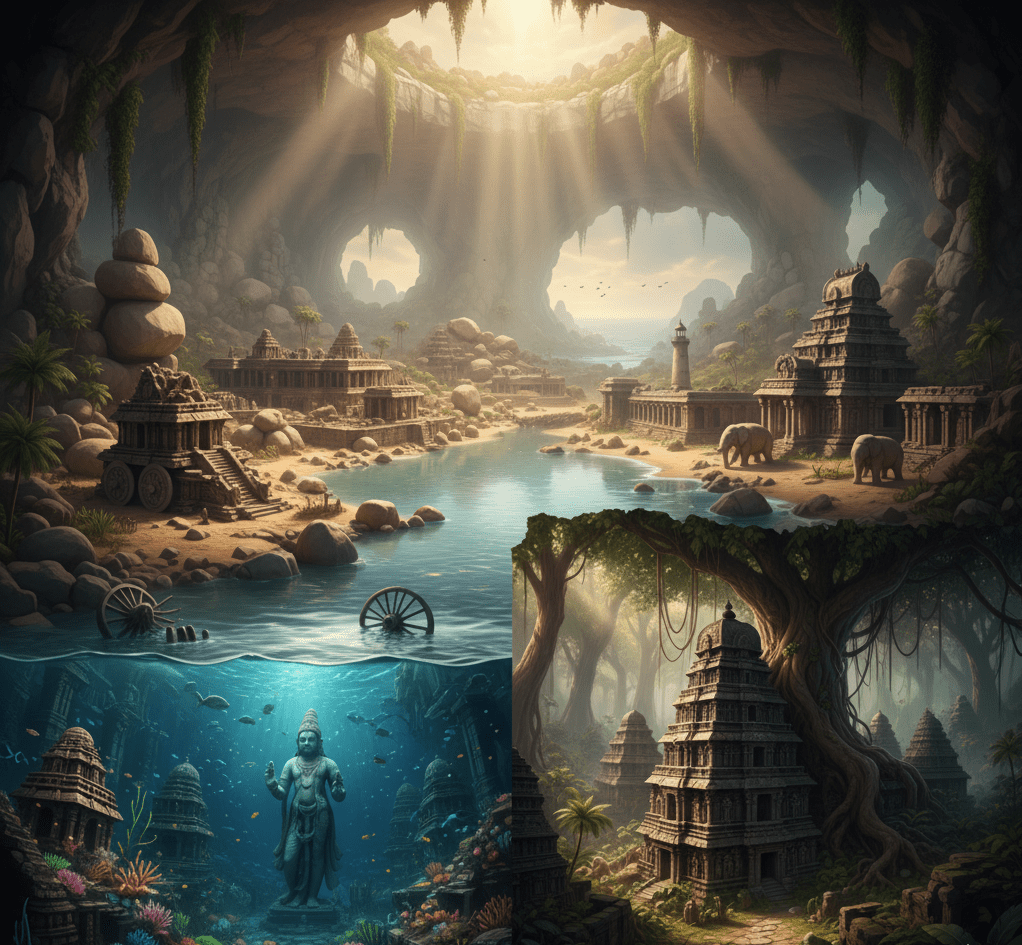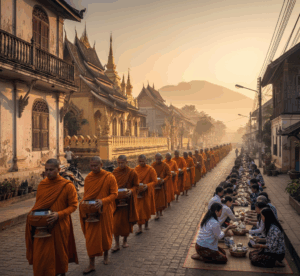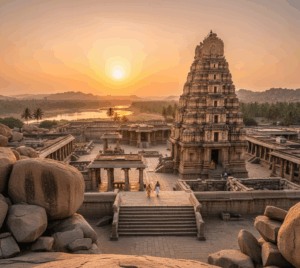Lost Cities of Ancient Hindu Kingdoms: Dwarka, Hampi, Koh Ker & Luang Prabang

Lost cities of ancient Hindu kingdoms beckon like half-remembered dreams — sunken harbors, temple-topped hills and jungle-swallowed pyramids where myth and archaeology meet. Let’s step into that world: visiting Dwarka submerged stones, Hampi’s granite colossi, Koh Ker’s pyramidous Lingapura and Luang Prabang’s river-lit wats, and trace how living traditions keep these places alive. This article stitches together history, legend and on-site wonder to help you imagine and plan to explore four extraordinary capitals that shaped faith, art and power across South and Southeast Asia.
Dwarka – Krishna’s Celestial City and a Sunken Port Gateway
Just off India’s western shores in the Arabian Sea stands Dwarka, Lord Krishna’s sunken city, still alive, not only in myth and memory but offering undisputed evidence of its former greatness. The Gulfs of Kutch and Khambat, off the eastern Saurashtra coast in Gujarat, preserve remains of some of the subcontinent’s oldest civilizations, including the Harappan period. Prominent sites include the famous Harappan port town of Lothal and sites like Padri and Hanuman-no-Timbo. But the jewel in its crown is the once mighty port city on the Arabian Sea, the golden capital of that ‘Supreme Personality of Godhead’, Lord Krishna, the city of Dwarka or Dvarika. Legend has it, and the Hindu scriptures actually describe, how, when the god‑king departed earth, “Dwarka and its inhabitants were submerged by the sea”. Even today pilgrims stream into today’s Dwarka – essentially in the same location – to visit the Dwarka-dhish Temple, unaware that beneath the waterline lies the ancient holy city’s remains. A 2002 report in New Scientist cited a carbon dating of 7500 BC for wooden samples from the site, suggesting it could be the world’s oldest city, pre-dating all known cities discovered till today. Marine archaeologists have unearthed coral-encrusted walls, stone foundations and carved anchors on the seafloor just off the coast. These findings give startling reality to the saga of a vanished city which, as UNESCO notes, was the very meaning of the name “Dwarka” i.e. “door” or “gateway”. Though surrounded by daily life, Dwarka feels steeped in legend. Imagine snorkelling around sunken blocks of sandstone, wondering if a Krishna statue might lie below. The fisherman’s tales, the evening prayers onshore and the golden rays at sunset all contribute to the mystical aura. In this sunlit turquoise bay, mythology and marine archaeology meet: the wonder isn’t in asking “Is it true?”, but in witnessing how ancient verse and stone clues inter-twine. Not far inland, modern Dwarka is still one of Hinduism’s seven holy cities. Each year devotees bathe in the Gomti River and celebrate Krishna’s legacy in grand festivals. Along the shoreline one can still spot fragments of old temple ruins and stone chains that once moored ships. Walking these shores, the transition from myth to memory feels seamless: a pilgrim might pray at a temple in the morning and, by afternoon, peer into the clear water seeking whatever remains of the “great and beautiful city” of Krishna.
Hampi – The Magnificent Capital of the Ancient Vijayanagara Empire
Hidden amid a surreal landscape of massive boulders and palm groves, Hampi was the bustling heart of the Vijayanagara Empire (circa 1336–1565 CE). Once described by foreign travellers as a city so magnificent that even heaven would be jealous, Hampi’s ruins today spread over nearly 4,200 hectares in Karnataka, South India. UNESCO calls it the “austere and grandiose site of the Vijayanagara capital”, an area dotted with more than 1,600 surviving structures. Today, village temple-goers and wandering monkeys walk among the remnants of royal palaces, temple cloisters and market streets that were consecrated centuries ago. Vijayanagara’s architects drew on Dravidian traditions but added their own flair. The most spectacular temple is Vitthala, famed for its carved stone chariot and elaborate pillared halls. Built during Hampi’s golden age, Vitthala exemplifies the final flowering of South Indian temple art. Other treasures include the Virupaksha temple (still in daily worship) and the Kamal Mahal (Lotus Palace) pavilion in the royal centre – all cut from local granite and decorated with intricate reliefs. According to UNESCO, these temples, bazaars and water tanks were integrated “harmoniously” with the surrounding natural setting. In their heyday they hosted Ratha Yatras (Chariot Processions), festivals and royal events. Even today, evening rituals and the gentle flow of pilgrims’ chants keep them alive. It is true that in India, the ancient co-exists with the modern even to this day. Nowhere is it more palpable than in Hampi, the last great Hindu empire which stands tall even now, amid huge granite boulders. The mythic aura of Hampi is enhanced by its dramatic scenery. The Tungabhadra River snakes past orange granite boulders, some balanced precariously on others like giant eggs. Local lore even connects Hampi to the Ramayana: it is identified with the ancient Kishkindha, the kingdom of the monkey kings Sugriva and Vali. As pilgrims’ light lamps along the riverbank at dusk, one can almost sense the Van Manav (People of the Forests – a type of Hominids from whom we Homo Sapiens have descended, erroneously called ‘monkeys’) army still roaming these hills. Even after the catastrophic 1565 defeat that shattered the empire, Hampi’s sacred core endured: the Virupaksha Temple was never abandoned and daily puja rituals have continued unhindered into modern times. Wandering among the ruins at sunrise, the visitor senses how a vanished metropolis still pulses with living tradition, blurring the line between history and mythology.
Lingapura (Koh Ker, Cambodia) – The Pyramid Capital
Deep in Cambodia’s jungles lies Koh Ker, the remote “Lost City” of the Khmer Empire. For a brief but dazzling period (928–944 CE), Koh Ker was the Khmer capital, then known as Lingapura. a Sanskrit-Hindu name. UNESCO describes it as a “sacred urban ensemble” of temples and shrines rising from a gentle hill. King Jayavarman IV, seeking cosmic symbolism, laid out this city according to ancient Hindu concepts of the universe. The centrepiece is Prasat Thom, a massive seven-tier pyramid over 30 meters tall – unlike anything seen at Angkor. Around it are dozens of smaller temple pads (lingas), earning Koh Ker its name “City of Lingams” (literally ‘City of Phalluses). Today the forest reclaims much of Lingapura. sandstone ruins are moss-covered, and the forest canopy drips rainwater onto the ruins. In the misty morning light, the stone gate – a monstrous trilithon of towers – looks like a door to another realm. Archaeologists have documented the grand temple enclosures and lintels, but Koh Ker’s mystique lies in its atmosphere: one can easily imagine ceremonies to Hindu deities or processions of priests up the pyramid steps. The UNESCO dossier emphasizes Koh Ker’s unconventional planning and use of gigantic monoliths. For the traveller, that eccentric layout only deepens the sense of wandering through a lost world. It’s easy to feel the ghosts of kings in this city of broken columns – a powerful reminder that even an empire’s proud capital can vanish without a trace, leaving only jungle and legend behind.
Muang Sua (Luang Prabang, Laos) – City of Buddha’s Smile

Muang Sua was under Khmer suzerainty for a brief period, notably under Jayavarman VII from 1185 to 1191. During this era, the powerful Khmer Empire, which had strong Hindu roots, influenced the region. Even before the Khmer Empire, from about the 6th century, there was significant cultural contact between ancient India and Southeast Asia. Hinduism, and later Buddhism, were spread peacefully through trade and cultural exchange, with local rulers and people adopting and adapting Indian ideals and customs. Manifestations of this Hindu-Buddhist blend can be clearly seen in Luang Prabang where the temples often exhibit a blend of Hindu and local beliefs, incorporation of Hindu deities and symbolism, such as divine dancers (Apsaras) and Nagas (serpents), within Buddhist architecture. Religious Syncretism is very evident in the architectural elements of these sites, where features like prang-style towers and bas-reliefs, common in Hindu-influenced architecture, are integrated into local designs. The city also had a history with Brahmanism, an ancient tradition within Hinduism, which worshipped supernatural powers. Hermits associated with these beliefs built pillars that became significant local landmarks. Perched on a peninsula between the Mekong and Nam Khan rivers, Luang Prabang evokes a peaceful enchantment. Legend holds that Gautama Buddha once smiled here as he passed through, prophesying that this humble riverside hamlet (then called Muang Sua) would one day be a great city. True to the tale, from the 14th through 16th centuries Luang Prabang served as the capital of the Lan Xang kingdom – the “Land of a Million Elephants” – thriving on trade along the silk route. What makes Luang Prabang feel otherworldly is its harmony of temples, traditions and nature. UNESCO notes the seamless fusion of Lao wooden temples and gilded shrines with French-colonial villas. At dawn, saffron-robed monks form silent lines for alms along narrow streets, while dragon-naga motifs guard the temple roofs. In the afternoon, travellers can climb sacred Mount Phousi or wander around ancient wars (Buddhist temples) by the riverbank. Each pagoda here – from the exquisite 16th‑century Wat Xieng Thong to countless village shrines – preserves Lao art and legend. Even today, locals honour the naga “water spirits” of the Mekong in colourful ceremonies. The combination of storybook architecture and living ritual gives Luang Prabang a timeless feel. In the evening, the old royal palaces and golden temples glow in the sunset, and it’s easy to imagine Buddha’s smile lingering in the warm breeze. As UNESCO observes, the townscape is remarkably intact, so that past and present coexist in harmony. Wandering its charming lanes, one senses that Luang Prabang’s history – whether divine or mortal – continues to shape every carved lintel and lotus pond.
Conclusion
Each of these cities – Dwarka, Hampi, Koh Ker’s Lingapura and Luang Prabang – remind us how myth and culture entwine with history. Pilgrims still circle Dwarka’s temple, and monks still chant in Hampi’s shrines. In Cambodia’s jungles, Koh Ker waits quietly, as if guarding its ancient secrets. And on the Mekong, Luang Prabang’s golden roofs seem to touch the heavens. UNESCO and archaeologists help us read the stones, but it is the living cultures and legends that truly animate these lost capitals of ancient Hinduism. Exploring them is less an academic dig and more an adventure in imagination – a voyage across time into lands where the line between history and story forever blurs.




https://shorturl.fm/EFz9Y
https://shorturl.fm/ZdCIk
https://shorturl.fm/ja1PT
https://shorturl.fm/ISeyA
https://shorturl.fm/sEyvG
https://shorturl.fm/rHYBV
https://shorturl.fm/FGwLR
https://shorturl.fm/LbcGJ
https://shorturl.fm/pkPHQ
https://shorturl.fm/yn91K
https://shorturl.fm/HQOi1
https://shorturl.fm/wKQoS
https://shorturl.fm/ToydL
https://shorturl.fm/kVWSK
https://shorturl.fm/5bOOT
https://shorturl.fm/6BPPU
https://shorturl.fm/YK6RT
https://shorturl.fm/3j7X4
https://shorturl.fm/x07Li
https://shorturl.fm/q22aC
https://shorturl.fm/CojWl
https://shorturl.fm/i0NWw
https://shorturl.fm/HRsL7
https://shorturl.fm/Vu1A7
https://shorturl.fm/hYZY3
https://shorturl.fm/KHua5
https://shorturl.fm/aO1Kl
https://shorturl.fm/fY8l5
https://shorturl.fm/C6J3t
https://shorturl.fm/GPBaY
https://shorturl.fm/2nEuS
https://shorturl.fm/ALwLJ
https://shorturl.fm/zsfl4
https://shorturl.fm/qTosJ
https://shorturl.fm/itnGP
https://shorturl.fm/HcenR
https://shorturl.fm/XcwwD
https://shorturl.fm/K5g7e
https://shorturl.fm/XzRuO
https://shorturl.fm/A5Hfl
https://shorturl.fm/p21FW
https://shorturl.fm/sPJQB
https://shorturl.fm/zQlrZ
https://shorturl.fm/QrFDI
https://shorturl.fm/fk479
https://shorturl.fm/c4T9x
https://shorturl.fm/Mfvd8
https://shorturl.fm/Z00S5
https://shorturl.fm/FlJhD
https://shorturl.fm/ejz7k
https://shorturl.fm/ybhCI
https://shorturl.fm/guQh7
https://shorturl.fm/jtX00
https://shorturl.fm/fNDhI
https://shorturl.fm/39av6
https://shorturl.fm/OxPVE
https://shorturl.fm/Is7jP
https://shorturl.fm/msRJf
https://shorturl.fm/jKd0W
https://shorturl.fm/kc5KB
https://shorturl.fm/JZodw
https://shorturl.fm/6rNqU
https://shorturl.fm/E5IZP
https://shorturl.fm/tr0iQ
https://shorturl.fm/dF9AM
https://shorturl.fm/OKgEs
https://shorturl.fm/CgEBN
https://shorturl.fm/luzjm
https://shorturl.fm/jw1bp
https://shorturl.fm/8cuPs
https://shorturl.fm/Ph36a
https://shorturl.fm/tJRit
https://shorturl.fm/TRI4Z
https://shorturl.fm/5oixV
https://shorturl.fm/Y7ZeR
https://shorturl.fm/idOIN
https://shorturl.fm/DBwLO
https://shorturl.fm/DgYmN
https://shorturl.fm/xAjZS
https://shorturl.fm/yQ8G9
https://shorturl.fm/c9LpY
https://shorturl.fm/7kd5C
https://shorturl.fm/8n6DM
https://shorturl.fm/mew7i
https://shorturl.fm/ZYe1z
https://shorturl.fm/zxT1F
https://shorturl.fm/kIAtS
https://shorturl.fm/JlspO
https://shorturl.fm/VHX32
https://shorturl.fm/yhXZE
https://shorturl.fm/ki3Oj
https://shorturl.fm/oxyhk
https://shorturl.fm/RF4xQ
https://shorturl.fm/Ub2dn
https://shorturl.fm/MX4i2
https://shorturl.fm/uY8Ep
https://shorturl.fm/dpr2N
https://shorturl.fm/k1bey